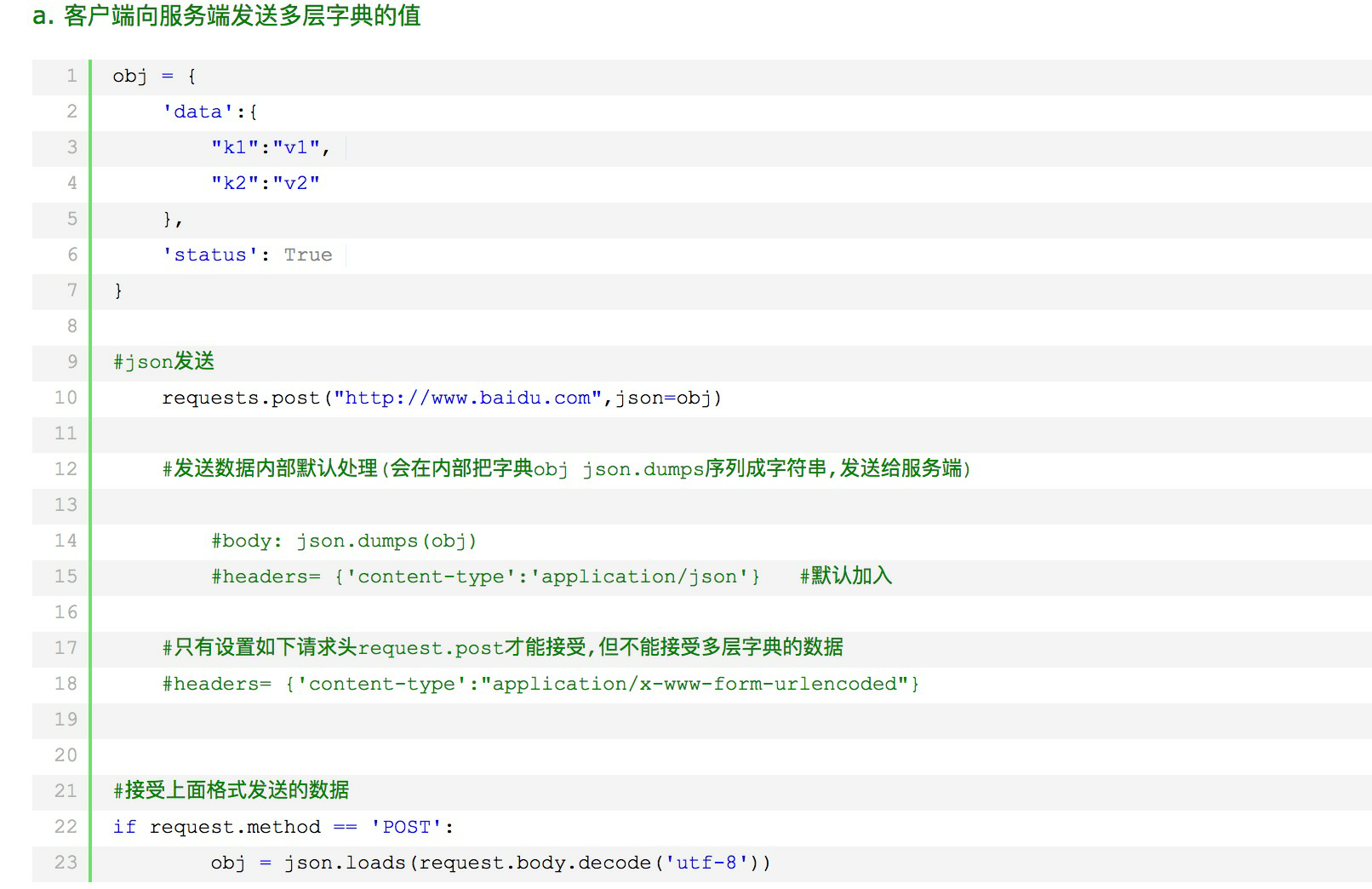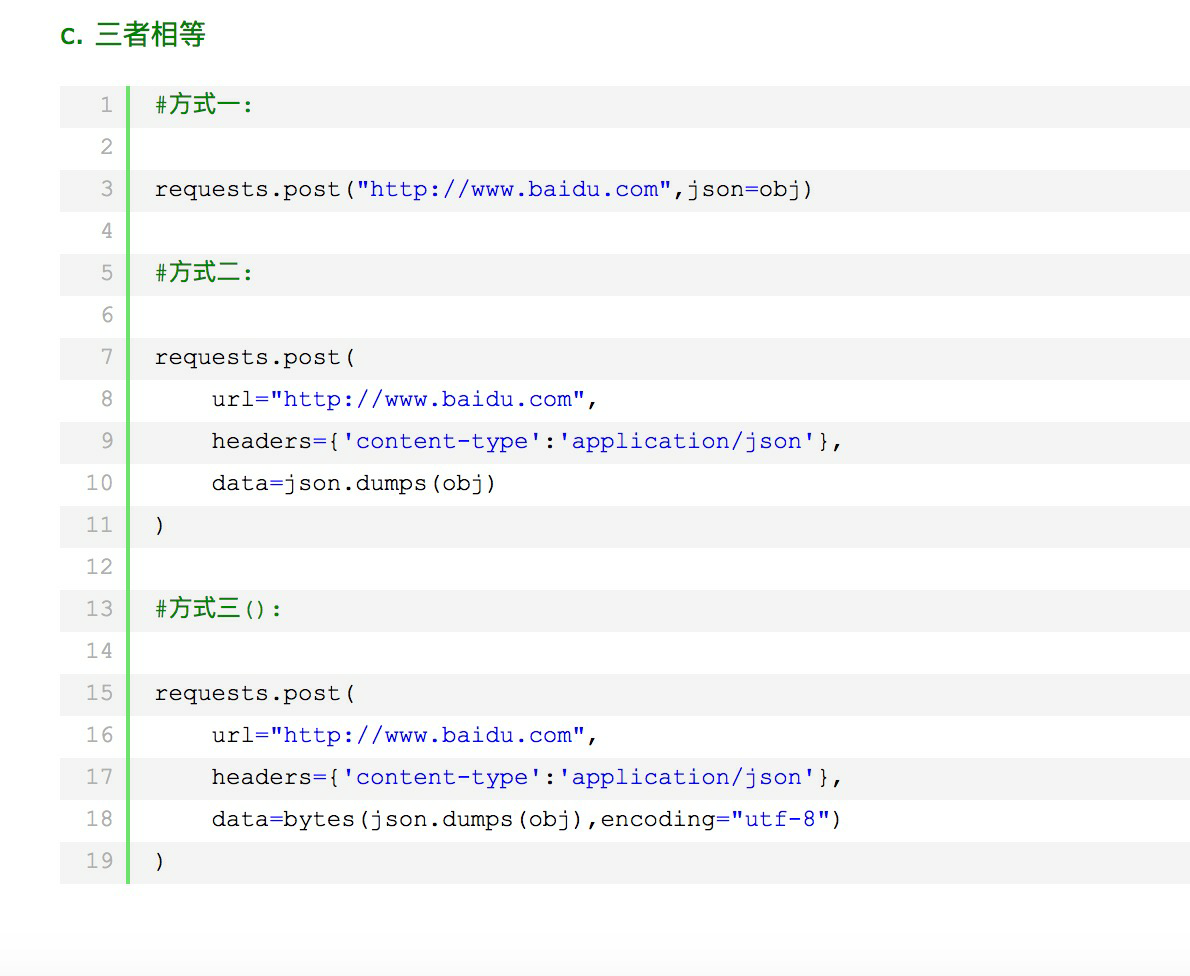requests
Requests 是使用 Apache2 Licensed 许可证的 基于Python开发的HTTP 库,其在Python内置模块的基础上进行了高度的封装,从而使得Pythoner进行网络请求时,变得美好了许多,使用Requests可以轻而易举的完成浏览器可有的任何操作。
1. get请求
1 # 1、无参数实例 2 3 import requests 4 5 ret = requests.get('https://github.com/timeline.json') 6 7 print ret.url 8 print ret.text 9 10 11 12 # 2、有参数实例 13 14 import requests 15 16 payload = {'key1': 'value1', 'key2': 'value2'} 17 ret = requests.get("http://httpbin.org/get", params=payload) 18 19 print ret.url 20 print ret.text
2 post请求
1 # 1、基本POST实例 2 3 import requests 4 5 payload = {'key1': 'value1', 'key2': 'value2'} 6 ret = requests.post("http://httpbin.org/post", data=payload) 7 8 print ret.text 9 10 11 # 2、发送请求头和数据实例 12 13 import requests 14 import json 15 16 url = 'https://api.github.com/some/endpoint' 17 payload = {'some': 'data'} 18 headers = {'content-type': 'application/json'} 19 注意:
requests.post(url='',json=payload) #默认请求头为‘application/json’
requests.post(url='',data=payload) #默认请求头为'application/x-www-form-/urlencoded'
20 ret = requests.post(url, data=json.dumps(payload), headers=headers)
21 ret = requests.post(url, json=payload, headers=headers)
ret = requests.post(url, data=payload, headers={'content-type': 'application/x-www-form-/urlencoded'})
22 print ret.text
23 print ret.cookies


3 其他请求
1 requests.get(url, params=None, **kwargs) 2 requests.post(url, data=None, json=None, **kwargs) 3 requests.put(url, data=None, **kwargs) 4 requests.head(url, **kwargs) 5 requests.delete(url, **kwargs) 6 requests.patch(url, data=None, **kwargs) 7 requests.options(url, **kwargs) 8 9 # 以上方法均是在此方法的基础上构建 10 requests.request(method, url, **kwargs)
4 更多参数

1 def request(method, url, **kwargs): 2 """Constructs and sends a :class:`Request <Request>`. 3 4 :param method: method for the new :class:`Request` object. 5 :param url: URL for the new :class:`Request` object. 6 :param params: (optional) Dictionary or bytes to be sent in the query string for the :class:`Request`. 7 :param data: (optional) Dictionary, bytes, or file-like object to send in the body of the :class:`Request`. 8 :param json: (optional) json data to send in the body of the :class:`Request`. 9 :param headers: (optional) Dictionary of HTTP Headers to send with the :class:`Request`. 10 :param cookies: (optional) Dict or CookieJar object to send with the :class:`Request`. 11 :param files: (optional) Dictionary of ``'name': file-like-objects`` (or ``{'name': file-tuple}``) for multipart encoding upload. 12 ``file-tuple`` can be a 2-tuple ``('filename', fileobj)``, 3-tuple ``('filename', fileobj, 'content_type')`` 13 or a 4-tuple ``('filename', fileobj, 'content_type', custom_headers)``, where ``'content-type'`` is a string 14 defining the content type of the given file and ``custom_headers`` a dict-like object containing additional headers 15 to add for the file. 16 :param auth: (optional) Auth tuple to enable Basic/Digest/Custom HTTP Auth. 17 :param timeout: (optional) How long to wait for the server to send data 18 before giving up, as a float, or a :ref:`(connect timeout, read 19 timeout) <timeouts>` tuple. 20 :type timeout: float or tuple 21 :param allow_redirects: (optional) Boolean. Set to True if POST/PUT/DELETE redirect following is allowed. 22 :type allow_redirects: bool 23 :param proxies: (optional) Dictionary mapping protocol to the URL of the proxy. 24 :param verify: (optional) whether the SSL cert will be verified. A CA_BUNDLE path can also be provided. Defaults to ``True``. 25 :param stream: (optional) if ``False``, the response content will be immediately downloaded. 26 :param cert: (optional) if String, path to ssl client cert file (.pem). If Tuple, ('cert', 'key') pair. 27 :return: :class:`Response <Response>` object 28 :rtype: requests.Response 29 30 Usage:: 31 32 >>> import requests 33 >>> req = requests.request('GET', 'http://httpbin.org/get') 34 <Response [200]> 35 """

1 def param_method_url(): 2 # requests.request(method='get', url='http://127.0.0.1:8000/test/') 3 # requests.request(method='post', url='http://127.0.0.1:8000/test/') 4 pass 5 6 7 def param_param(): 8 # - 可以是字典 9 # - 可以是字符串 10 # - 可以是字节(ascii编码以内) 11 12 # requests.request(method='get', 13 # url='http://127.0.0.1:8000/test/', 14 # params={'k1': 'v1', 'k2': '水电费'}) 15 16 # requests.request(method='get', 17 # url='http://127.0.0.1:8000/test/', 18 # params="k1=v1&k2=水电费&k3=v3&k3=vv3") 19 20 # requests.request(method='get', 21 # url='http://127.0.0.1:8000/test/', 22 # params=bytes("k1=v1&k2=k2&k3=v3&k3=vv3", encoding='utf8')) 23 24 # 错误 25 # requests.request(method='get', 26 # url='http://127.0.0.1:8000/test/', 27 # params=bytes("k1=v1&k2=水电费&k3=v3&k3=vv3", encoding='utf8')) 28 pass 29 30 31 def param_data(): 32 # 可以是字典 33 # 可以是字符串 34 # 可以是字节 35 # 可以是文件对象 36 37 # requests.request(method='POST', 38 # url='http://127.0.0.1:8000/test/', 39 # data={'k1': 'v1', 'k2': '水电费'}) 40 41 # requests.request(method='POST', 42 # url='http://127.0.0.1:8000/test/', 43 # data="k1=v1; k2=v2; k3=v3; k3=v4" 44 # ) 45 46 # requests.request(method='POST', 47 # url='http://127.0.0.1:8000/test/', 48 # data="k1=v1;k2=v2;k3=v3;k3=v4", 49 # headers={'Content-Type': 'application/x-www-form-urlencoded'} 50 # ) 51 52 # requests.request(method='POST', 53 # url='http://127.0.0.1:8000/test/', 54 # data=open('data_file.py', mode='r', encoding='utf-8'), # 文件内容是:k1=v1;k2=v2;k3=v3;k3=v4 55 # headers={'Content-Type': 'application/x-www-form-urlencoded'} 56 # ) 57 pass 58 59 60 def param_json(): 61 # 将json中对应的数据进行序列化成一个字符串,json.dumps(...) 62 # 然后发送到服务器端的body中,并且Content-Type是 {'Content-Type': 'application/json'} 63 requests.request(method='POST', 64 url='http://127.0.0.1:8000/test/', 65 json={'k1': 'v1', 'k2': '水电费'}) 66 67 68 def param_headers(): 69 # 发送请求头到服务器端 70 requests.request(method='POST', 71 url='http://127.0.0.1:8000/test/', 72 json={'k1': 'v1', 'k2': '水电费'}, 73 headers={'Content-Type': 'application/x-www-form-urlencoded'} 74 ) 75 76 77 def param_cookies(): 78 # 发送Cookie到服务器端 79 requests.request(method='POST', 80 url='http://127.0.0.1:8000/test/', 81 data={'k1': 'v1', 'k2': 'v2'}, 82 cookies={'cook1': 'value1'}, 83 ) 84 # 也可以使用CookieJar(字典形式就是在此基础上封装) 85 from http.cookiejar import CookieJar 86 from http.cookiejar import Cookie 87 88 obj = CookieJar() 89 obj.set_cookie(Cookie(version=0, name='c1', value='v1', port=None, domain='', path='/', secure=False, expires=None, 90 discard=True, comment=None, comment_url=None, rest={'HttpOnly': None}, rfc2109=False, 91 port_specified=False, domain_specified=False, domain_initial_dot=False, path_specified=False) 92 ) 93 requests.request(method='POST', 94 url='http://127.0.0.1:8000/test/', 95 data={'k1': 'v1', 'k2': 'v2'}, 96 cookies=obj) 97 98 99 def param_files(): 100 # 发送文件 101 # file_dict = { 102 # 'f1': open('readme', 'rb') 103 # } 104 # requests.request(method='POST', 105 # url='http://127.0.0.1:8000/test/', 106 # files=file_dict) 107 108 # 发送文件,定制文件名 109 # file_dict = { 110 # 'f1': ('test.txt', open('readme', 'rb')) 111 # } 112 # requests.request(method='POST', 113 # url='http://127.0.0.1:8000/test/', 114 # files=file_dict) 115 116 # 发送文件,定制文件名 117 # file_dict = { 118 # 'f1': ('test.txt', "hahsfaksfa9kasdjflaksdjf") 119 # } 120 # requests.request(method='POST', 121 # url='http://127.0.0.1:8000/test/', 122 # files=file_dict) 123 124 # 发送文件,定制文件名 125 # file_dict = { 126 # 'f1': ('test.txt', "hahsfaksfa9kasdjflaksdjf", 'application/text', {'k1': '0'}) 127 # } 128 # requests.request(method='POST', 129 # url='http://127.0.0.1:8000/test/', 130 # files=file_dict) 131 132 pass 133 134 135 def param_auth(): 136 from requests.auth import HTTPBasicAuth, HTTPDigestAuth 137 138 ret = requests.get('https://api.github.com/user', auth=HTTPBasicAuth('wupeiqi', 'sdfasdfasdf')) 139 print(ret.text) 140 141 # ret = requests.get('http://192.168.1.1', 142 # auth=HTTPBasicAuth('admin', 'admin')) 143 # ret.encoding = 'gbk' 144 # print(ret.text) 145 146 # ret = requests.get('http://httpbin.org/digest-auth/auth/user/pass', auth=HTTPDigestAuth('user', 'pass')) 147 # print(ret) 148 # 149 150 151 def param_timeout(): 152 # ret = requests.get('http://google.com/', timeout=1) 153 # print(ret) 154 155 # ret = requests.get('http://google.com/', timeout=(5, 1)) 156 # print(ret) 157 pass 158 159 160 def param_allow_redirects(): 161 ret = requests.get('http://127.0.0.1:8000/test/', allow_redirects=False) 162 print(ret.text) 163 164 165 def param_proxies(): 166 # proxies = { 167 # "http": "61.172.249.96:80", 168 # "https": "http://61.185.219.126:3128", 169 # } 170 171 # proxies = {'http://10.20.1.128': 'http://10.10.1.10:5323'} 172 173 # ret = requests.get("http://www.proxy360.cn/Proxy", proxies=proxies) 174 # print(ret.headers) 175 176 177 # from requests.auth import HTTPProxyAuth 178 # 179 # proxyDict = { 180 # 'http': '77.75.105.165', 181 # 'https': '77.75.105.165' 182 # } 183 # auth = HTTPProxyAuth('username', 'mypassword') 184 # 185 # r = requests.get("http://www.google.com", proxies=proxyDict, auth=auth) 186 # print(r.text) 187 188 pass 189 190 191 def param_stream(): 192 ret = requests.get('http://127.0.0.1:8000/test/', stream=True) 193 print(ret.content) 194 ret.close() 195 196 # from contextlib import closing 197 # with closing(requests.get('http://httpbin.org/get', stream=True)) as r: 198 # # 在此处理响应。 199 # for i in r.iter_content(): 200 # print(i) 201 202 203 def requests_session(): 204 import requests 205 206 session = requests.Session() 207 208 ### 1、首先登陆任何页面,获取cookie 209 210 i1 = session.get(url="http://dig.chouti.com/help/service") 211 212 ### 2、用户登陆,携带上一次的cookie,后台对cookie中的 gpsd 进行授权 213 i2 = session.post( 214 url="http://dig.chouti.com/login", 215 data={ 216 'phone': "8615131255089", 217 'password': "xxxxxx", 218 'oneMonth': "" 219 } 220 ) 221 222 i3 = session.post( 223 url="http://dig.chouti.com/link/vote?linksId=8589623", 224 ) 225 print(i3.text)
BeautifulSoup
BeautifulSoup是一个模块,该模块用于接收一个HTML或XML字符串,然后将其进行格式化,之后遍可以使用他提供的方法进行快速查找指定元素,从而使得在HTML或XML中查找指定元素变得简单。
处理依赖
|
1
|
pip3 install beautifulsoup4 |
使用示例:
|
1
2
3
4
5
6
7
8
9
10
11
|
from bs4 import BeautifulSouphtml_doc = """<html><head><title>The Dormouse's story</title></head><body> ...</body></html>"""soup = BeautifulSoup(html_doc, features="lxml") |
1. name,标签名称
# tag = soup.find('a')
# name = tag.name # 获取
# print(name)
# tag.name = 'span' # 设置
# print(soup)
2. attr,标签属性
# tag = soup.find('a')
# attrs = tag.attrs # 获取
# print(attrs)
# tag.attrs = {'ik':123} # 设置
# tag.attrs['id'] = 'iiiii' # 设置
# print(soup)
3. children,所有子标签
# body = soup.find('body')
# v = body.children
4. children,所有子子孙孙标签
# body = soup.find('body')
# v = body.descendants
5. clear,将标签的所有子标签全部清空(保留标签名)
# tag = soup.find('body')
# tag.clear()
# print(soup)
6. decompose,递归的删除所有的标签
# body = soup.find('body')
# body.decompose()
# print(soup)
7. extract,递归的删除所有的标签,并获取删除的标签
# body = soup.find('body')
# v = body.extract()
# print(soup)
8. decode,转换为字符串(含当前标签);decode_contents(不含当前标签)
# body = soup.find('body')
# v = body.decode()
# v = body.decode_contents()
# print(v)
9. encode,转换为字节(含当前标签);encode_contents(不含当前标签)
# body = soup.find('body')
# v = body.encode()
# v = body.encode_contents()
# print(v)
10. find,获取匹配的第一个标签
# tag = soup.find('a')
# print(tag)
# tag = soup.find(name='a', attrs={'class': 'sister'}, recursive=True, text='Lacie')
# tag = soup.find(name='a', class_='sister', recursive=True, text='Lacie')
# print(tag)
11. find_all,获取匹配的所有标签
# tags = soup.find_all('a')
# print(tags)
# tags = soup.find_all('a',limit=1)
# print(tags)
# tags = soup.find_all(name='a', attrs={'class': 'sister'}, recursive=True, text='Lacie')
# # tags = soup.find(name='a', class_='sister', recursive=True, text='Lacie')
# print(tags)
# ####### 列表 #######
# v = soup.find_all(name=['a','div'])
# print(v)
# v = soup.find_all(class_=['sister0', 'sister'])
# print(v)
# v = soup.find_all(text=['Tillie'])
# print(v, type(v[0]))
# v = soup.find_all(id=['link1','link2'])
# print(v)
# v = soup.find_all(href=['link1','link2'])
# print(v)
# ####### 正则 #######
import re
# rep = re.compile('p')
# rep = re.compile('^p')
# v = soup.find_all(name=rep)
# print(v)
# rep = re.compile('sister.*')
# v = soup.find_all(class_=rep)
# print(v)
# rep = re.compile('http://www.oldboy.com/static/.*')
# v = soup.find_all(href=rep)
# print(v)
# ####### 方法筛选 #######
# def func(tag):
# return tag.has_attr('class') and tag.has_attr('id')
# v = soup.find_all(name=func)
# print(v)
# ## get,获取标签属性
# tag = soup.find('a')
# v = tag.get('id')
# print(v)
12. has_attr,检查标签是否具有该属性
# tag = soup.find('a')
# v = tag.has_attr('id')
# print(v)
13. get_text,获取标签内部文本内容
# tag = soup.find('a')
# v = tag.get_text('id')
# print(v)
14. index,检查标签在某标签中的索引位置
# tag = soup.find('body')
# v = tag.index(tag.find('div'))
# print(v)
# tag = soup.find('body')
# for i,v in enumerate(tag):
# print(i,v)
15. is_empty_element,是否是空标签(是否可以是空)或者自闭合标签,
判断是否是如下标签:'br' , 'hr', 'input', 'img', 'meta','spacer', 'link', 'frame', 'base'
# tag = soup.find('br')
# v = tag.is_empty_element
# print(v)
16. 当前的关联标签
# soup.next # soup.next_element # soup.next_elements # soup.next_sibling # soup.next_siblings # # tag.previous # tag.previous_element # tag.previous_elements # tag.previous_sibling # tag.previous_siblings # # tag.parent # tag.parents
17. 查找某标签的关联标签
# tag.find_next(...) # tag.find_all_next(...) # tag.find_next_sibling(...) # tag.find_next_siblings(...) # tag.find_previous(...) # tag.find_all_previous(...) # tag.find_previous_sibling(...) # tag.find_previous_siblings(...) # tag.find_parent(...) # tag.find_parents(...) # 参数同find_all
18. select,select_one, CSS选择器
soup.select("title")
soup.select("p nth-of-type(3)")
soup.select("body a")
soup.select("html head title")
tag = soup.select("span,a")
soup.select("head > title")
soup.select("p > a")
soup.select("p > a:nth-of-type(2)")
soup.select("p > #link1")
soup.select("body > a")
soup.select("#link1 ~ .sister")
soup.select("#link1 + .sister")
soup.select(".sister")
soup.select("[class~=sister]")
soup.select("#link1")
soup.select("a#link2")
soup.select('a[href]')
soup.select('a[href="http://example.com/elsie"]')
soup.select('a[href^="http://example.com/"]')
soup.select('a[href$="tillie"]')
soup.select('a[href*=".com/el"]')
from bs4.element import Tag
def default_candidate_generator(tag):
for child in tag.descendants:
if not isinstance(child, Tag):
continue
if not child.has_attr('href'):
continue
yield child
tags = soup.find('body').select("a", _candidate_generator=default_candidate_generator)
print(type(tags), tags)
from bs4.element import Tag
def default_candidate_generator(tag):
for child in tag.descendants:
if not isinstance(child, Tag):
continue
if not child.has_attr('href'):
continue
yield child
tags = soup.find('body').select("a", _candidate_generator=default_candidate_generator, limit=1)
print(type(tags), tags)
19. 标签的内容
# tag = soup.find('span')
# print(tag.string) # 获取
# tag.string = 'new content' # 设置
# print(soup)
# tag = soup.find('body')
# print(tag.string)
# tag.string = 'xxx'
# print(soup)
# tag = soup.find('body')
# v = tag.stripped_strings # 递归内部获取所有标签的文本
# print(v)
20.append在当前标签内部追加一个标签
# tag = soup.find('body')
# tag.append(soup.find('a'))
# print(soup)
#
# from bs4.element import Tag
# obj = Tag(name='i',attrs={'id': 'it'})
# obj.string = '我是一个新来的'
# tag = soup.find('body')
# tag.append(obj)
# print(soup)
21.insert在当前标签内部指定位置插入一个标签
# from bs4.element import Tag
# obj = Tag(name='i', attrs={'id': 'it'})
# obj.string = '我是一个新来的'
# tag = soup.find('body')
# tag.insert(2, obj)
# print(soup)
22. insert_after,insert_before 在当前标签后面或前面插入
# from bs4.element import Tag
# obj = Tag(name='i', attrs={'id': 'it'})
# obj.string = '我是一个新来的'
# tag = soup.find('body')
# # tag.insert_before(obj)
# tag.insert_after(obj)
# print(soup)
23. replace_with 在当前标签替换为指定标签
# from bs4.element import Tag
# obj = Tag(name='i', attrs={'id': 'it'})
# obj.string = '我是一个新来的'
# tag = soup.find('div')
# tag.replace_with(obj)
# print(soup)
24. 创建标签之间的关系
# tag = soup.find('div')
# a = soup.find('a')
# tag.setup(previous_sibling=a)
# print(tag.previous_sibling)
25. wrap,将指定标签把当前标签包裹起来
# from bs4.element import Tag
# obj1 = Tag(name='div', attrs={'id': 'it'})
# obj1.string = '我是一个新来的'
#
# tag = soup.find('a')
# v = tag.wrap(obj1)
# print(soup)
# tag = soup.find('a')
# v = tag.wrap(soup.find('p'))
# print(soup)
26. unwrap,去掉当前标签,将保留其包裹的标签
# tag = soup.find('a')
# v = tag.unwrap()
# print(soup)
后台插件过滤:
 View Code
View Code基于__new__实现单例模式示例:
 View Code
View Code